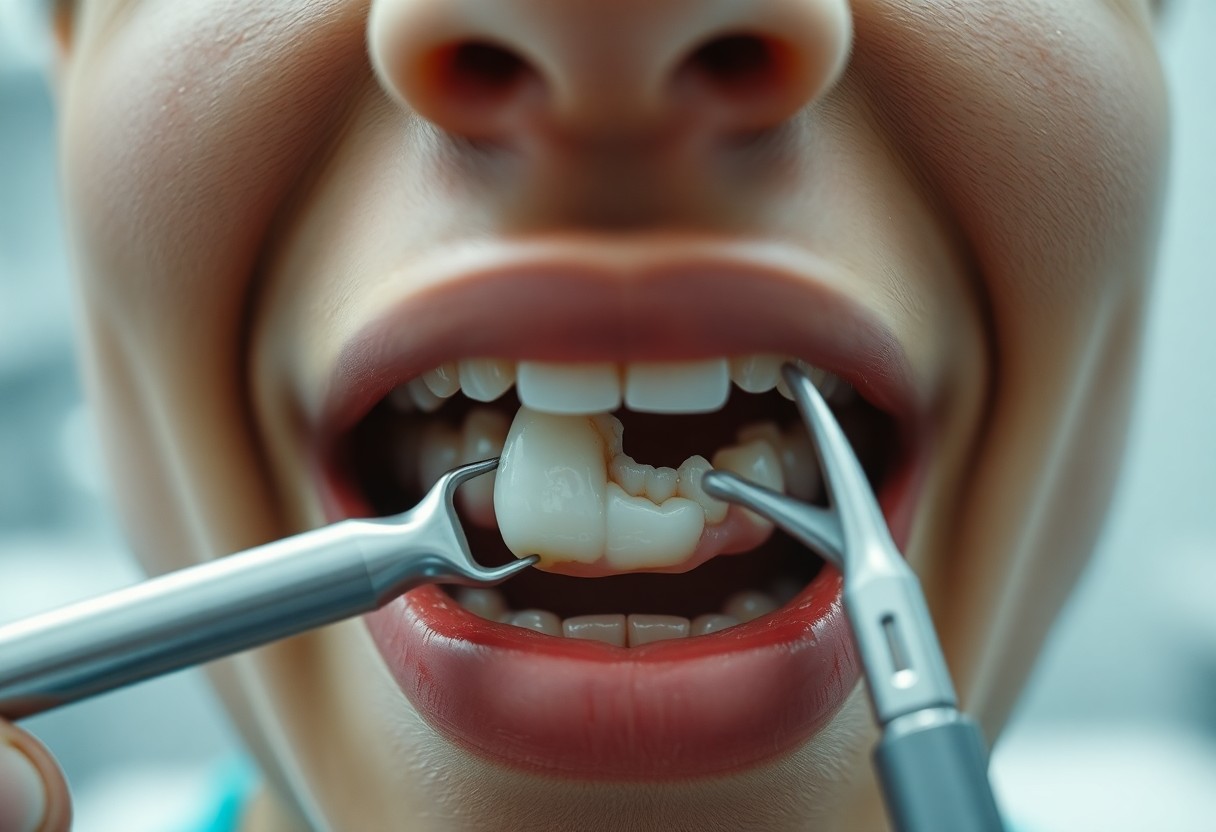Chipped Tooth Emergency
It’s alarming when you suddenly discover a chipped tooth, whether from biting down on something hard or after an accidental impact. Your immediate actions can make a significant difference in saving your tooth and preventing further damage. While a minor chip might only affect your smile’s appearance, larger breaks can expose sensitive inner layers of your tooth, leading to pain and potential complications. Understanding the right steps to take in these first moments will help you protect your dental health and increase the chances of a successful repair.
Immediate Actions
A chipped tooth requires quick action to prevent further damage and minimize discomfort. If you’ve just chipped your tooth, first rinse your mouth with warm water to clean the area. Save any broken pieces by placing them in milk or saline solution. Apply a cold compress to the outside of your cheek near the affected area to reduce swelling and contact your dentist immediately for an emergency appointment.
Pain Management
On experiencing tooth pain from a chip, you can take over-the-counter pain relievers like ibuprofen to manage discomfort. Avoid extremely hot or cold foods and beverages as your tooth may be sensitive. You can also use oral numbing gels containing benzocaine to temporarily relieve pain, but don’t exceed the recommended dosage on the package.
Temporary Protection Methods
On discovering a chipped tooth, you can use temporary dental cement from a pharmacy to cover the damaged area. If dental cement isn’t available, sugar-free wax or temporary filling material can provide short-term protection. These methods help shield the exposed area from temperature changes and food particles until you can see your dentist.
Understanding temporary protection options gives you more control over your situation. You can find dental repair kits at most pharmacies, which include dental wax and temporary filling materials. Apply these materials gently to the chipped area, following package instructions carefully. While these solutions offer temporary relief, they don’t replace professional dental care, and you should see your dentist as soon as possible.
Types of Tooth Chips
You might encounter different types of tooth damage, ranging from minor surface chips to severe fractures. Understanding the severity of your tooth chip helps determine the appropriate treatment approach.
- Minor surface chips
- Moderate chips affecting enamel
- Deep chips reaching dentin
- Severe fractures with pulp exposure
Knowing the characteristics of each type will guide you in seeking the right dental care.
| Type | Description |
|---|---|
| Surface Chip | Small enamel damage, cosmetic issue |
| Moderate Chip | Deeper enamel damage, may cause sensitivity |
| Deep Chip | Reaches dentin layer, requires prompt treatment |
| Severe Fracture | Exposes pulp, causes pain, dental emergency |
| Root Fracture | Extends below gumline, requires immediate care |
Minor Surface Chips
About 80% of tooth chips affect only the enamel layer. These superficial damages typically don’t cause pain but may create sharp edges that irritate your tongue or cheek. Your dentist can usually repair these chips in one visit using dental bonding or smoothing techniques.
Severe Fractures
Tooth fractures that extend deep into your tooth structure require immediate professional attention. When your tooth’s inner layers are exposed, you may experience significant pain and sensitivity to temperature changes.
Chips that reach the pulp can lead to infection if left untreated. You should avoid hot and cold foods, keep the area clean, and see your dentist immediately. Your treatment options may include root canal therapy or, in extreme cases, extraction and replacement with an implant.
What to do with a chipped tooth:
1. Rinse your mouth with warm water
2. Apply a cold compress to reduce swelling
3. Cover sharp edges with dental wax
4. Take over-the-counter pain relievers
5. Visit your dentist as soon as possible
6. Save any broken pieces in milk
7. Avoid chewing on the affected side
8. Keep the area clean to prevent infection
Risk Assessment
If your tooth has chipped, quick assessment of the situation can help you determine the urgency of dental care needed. You’ll need to evaluate three key factors: the size of the chip, presence of pain, and any bleeding. A small chip might only require cosmetic attention, while larger breaks demand immediate professional care.
Pain Levels
Across different types of tooth chips, pain can vary significantly. You might experience no discomfort with minor chips, while deeper breaks can cause sharp pain when exposed to hot, cold, or sweet substances. If you feel constant throbbing or severe pain, this indicates possible nerve damage requiring urgent dental attention.
Bleeding Signs
Risk of bleeding increases with deeper chips that extend below the enamel into the dentin or pulp. You should check for any pink or red tinge around the damaged area, which could indicate exposed tooth pulp or injured gum tissue.
Indeed, bleeding from a chipped tooth requires your immediate attention. If you notice blood, rinse your mouth gently with lukewarm water and apply light pressure using a clean piece of gauze. You can use an ice pack on your cheek to reduce swelling and minimize bleeding while you make your way to an emergency dentist.
Home Care Steps
Your immediate response to a chipped tooth can help prevent further damage and reduce discomfort. Rinse your mouth with warm water to clean the area, and apply a cold compress to minimize swelling. If the chip has created a sharp edge, you can temporarily cover it with dental wax from your local pharmacy to protect your tongue and cheeks from cuts.
Temporary Fixes
Along with dental wax, temporary filling material available at pharmacies can protect the damaged tooth until you see your dentist. You can also use a tea bag as a compress to help with any bleeding, and clove oil can provide natural pain relief. These solutions are meant to be short-term fixes while you arrange professional dental care.
Diet Modifications
For the time being, stick to soft foods and avoid anything that requires excessive chewing. Keep your meals at room temperature, as extreme temperatures can trigger sensitivity in the damaged tooth. Avoid hard, crunchy, or sticky foods that could cause additional damage.
Steps to modify your diet include cutting food into smaller pieces, chewing on the unaffected side, and avoiding foods like nuts, hard candies, and tough meats. Choose yogurt, smoothies, soups, mashed potatoes, and well-cooked vegetables. Stay away from acidic foods and beverages that might irritate the affected area.
Professional Treatment Options
All chipped tooth treatments depend on the severity of your damage. Your dentist will examine the affected tooth and recommend the most suitable solution. From simple bonding procedures to full crown installations, professional intervention ensures proper restoration of your tooth’s function and appearance. Your dentist might also take X-rays to check for additional damage that’s not visible to the naked eye.
Dental Bonding
Professional dental bonding offers a quick and effective solution for minor chips. Your dentist will apply a tooth-colored composite resin to the damaged area, shape it to match your natural tooth, and harden it with a special light. This procedure typically takes 30-60 minutes and can last several years with proper care.
Crown Procedures
Above all, dental crowns provide the most comprehensive protection for severely chipped teeth. Your dentist will reshape the damaged tooth and create a custom-made cap that fits perfectly over it. Made from porcelain, ceramic, or metal alloys, crowns restore both the appearance and functionality of your tooth.
In addition to protecting your damaged tooth, crowns prevent further deterioration and potential nerve exposure. You’ll need to visit your dentist at least twice – first for preparing the tooth and getting a temporary crown, and then for the permanent crown installation. With proper care, your crown can last 10-15 years or more.
Prevention Measures
Not all dental accidents can be prevented, but you can significantly reduce your risk of chipping a tooth by taking proper precautions. Your daily habits and protective measures play a key role in maintaining your dental health and preventing unwanted injuries.
Protective Equipment
Before engaging in any contact sports or high-impact activities, you should wear a properly fitted mouthguard. Your dentist can create a custom mouthguard that offers superior protection compared to over-the-counter options. This simple step can save you from painful dental emergencies and expensive repairs.
Lifestyle Adjustments
With some mindful changes to your daily routine, you can protect your teeth from damage. Avoid using your teeth as tools to open packages or bottles, and be cautious when eating hard foods like candy, ice, or nuts. Your teeth are strong but not indestructible.
Measures to protect your teeth should include regular dental check-ups to identify weak spots before they become problems. You can strengthen your teeth by maintaining good oral hygiene, using fluoride products, and avoiding excessive consumption of acidic beverages. These simple changes can help preserve your dental health and prevent chips and cracks.
Summing up
Conclusively, when you experience a chipped tooth, your immediate response should be to rinse your mouth with warm water and apply a cold compress to minimize swelling. If you can locate the broken piece, store it in milk or saline solution. Contact your dentist immediately for an emergency appointment, as prompt professional care can prevent further damage and increase the chances of saving your tooth. Until you receive treatment, you can temporarily cover the sharp edges with dental wax to protect your tongue and cheeks from cuts.
FAQ
Q: What immediate steps should I take if I chip my tooth?
A: First, rinse your mouth with warm water to clean the area. Save any broken pieces of tooth and store them in milk or saliva. Apply a cold compress to reduce swelling and take over-the-counter pain medication if needed. Contact your dentist immediately for an emergency appointment, as prompt treatment can prevent further damage and infection.
Q: How do I know if my chipped tooth requires emergency dental care?
A: Seek immediate dental care if you experience severe pain, sharp edges that hurt your tongue or cheek, exposure of the tooth’s nerve (yellow or pink dot in the center), or if the chip is larger than 1/4 of the tooth. Additionally, if the damage extends below the gum line or causes bleeding that won’t stop, you should visit an emergency dentist right away.
Q: What temporary solutions can I use until I see a dentist?
A: You can use temporary dental cement from a pharmacy to cover the chipped area. Dental wax can also help protect your tongue and cheeks from sharp edges. If eating is necessary, stick to soft foods and avoid biting with the damaged tooth. Avoid very hot or cold foods to prevent sensitivity and pain. These measures are only temporary solutions until professional treatment is available.

